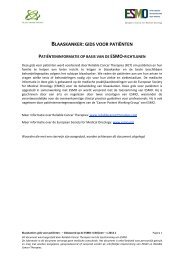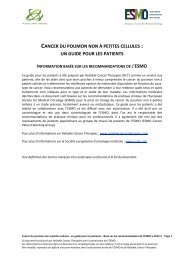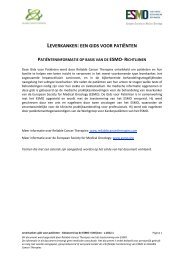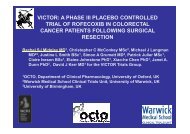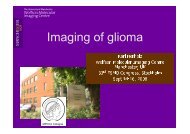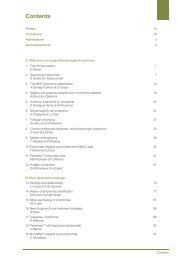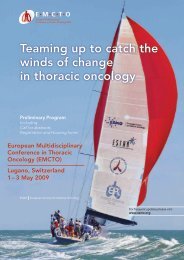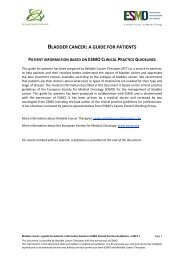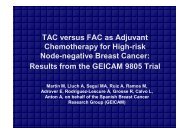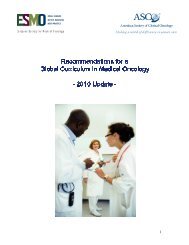Dual therapy shows potential in melanoma - European Society for ...
Dual therapy shows potential in melanoma - European Society for ...
Dual therapy shows potential in melanoma - European Society for ...
Create successful ePaper yourself
Turn your PDF publications into a flip-book with our unique Google optimized e-Paper software.
Sunday 30 September 2012 Congress Daily www.esmo.org Sunday 30 September 2012 Congress Daily www.esmo.org<br />
posters draw<br />
crowds at eSmO<br />
Daily Editorial<br />
treatment of <strong>melanoma</strong> W<strong>in</strong>n<strong>in</strong>g comb<strong>in</strong>ation<br />
makes headway <strong>for</strong> gastric cancer<br />
Treatment choices based on risk factors<br />
An educational session held yesterday, which<br />
focused on the the diagnosis and management of<br />
advanced <strong>melanoma</strong>, revealed the extraord<strong>in</strong>ary<br />
progress made <strong>in</strong> the past few years.<br />
Professor Boris Bastian from the University of<br />
Cali<strong>for</strong>nia San Francisco (UCSF), Cali<strong>for</strong>nia, USA,<br />
provided an overview of the latest <strong>in</strong>sights <strong>in</strong>to<br />
<strong>melanoma</strong> patho-biology. Melanoma gene discovery,<br />
he said, has occurred <strong>in</strong> ‘an era of massive parallel<br />
sequenc<strong>in</strong>g’, with over eight genotype phenotypes<br />
now identified <strong>in</strong> primary <strong>melanoma</strong>s.<br />
The susceptibility hypothesis holds that BRAF<br />
dependent <strong>melanoma</strong>s develop <strong>in</strong> younger patients,<br />
whereas <strong>in</strong>dependent mutations develop <strong>in</strong> older<br />
patients. However, other significant mutations have<br />
now been identified, <strong>in</strong>clud<strong>in</strong>g NRAS, TP53, PTEN,<br />
PPP6C, CDKN2A, MAP2KI, SNX31, STK19, RAC1<br />
and TACCC1.<br />
“Melanomas are a genetically and phenotypically<br />
diverse group of biologically dist<strong>in</strong>ct entities.<br />
Integrat<strong>in</strong>g molecular and phenotypic features<br />
would lead to an improved, more cl<strong>in</strong>ically relevant<br />
taxomy,” said Professor Bastian.<br />
Professor Re<strong>in</strong>hard Dummer, from the University<br />
of Zurich, Switzerland, <strong>in</strong><strong>for</strong>med delegates that <strong>for</strong><br />
over 30 years, the standard of care <strong>for</strong> patients<br />
with advanced <strong>melanoma</strong> has been s<strong>in</strong>gle-agent<br />
dacarbaz<strong>in</strong>e (DTIC) which <strong>in</strong> trials has displayed<br />
response rates of 7 15%. But the discovery of BRAF<br />
mutations <strong>in</strong> 66% of <strong>melanoma</strong>s has resulted <strong>in</strong> the<br />
development of BRAF <strong>in</strong>hibitors, with vemurafenib<br />
lead<strong>in</strong>g the way. The Phase 3 trial showed that<br />
vemurafenib was associated with a 63% reduction<br />
<strong>in</strong> the risk of death compared to DTIC.<br />
Professor Dirk Schadendorf from the University<br />
Hospital Essen, Germany, explored the new<br />
approach to immuno<strong>therapy</strong>. Melanoma<br />
immuno<strong>therapy</strong>, he said, has a ceil<strong>in</strong>g response <strong>in</strong><br />
the order of 10 – 20% of patients.<br />
“While responses can take time, once there<br />
is a response it tends to be durable and some<br />
patients are seem<strong>in</strong>gly cured,” said Professor<br />
Schadendorf. Cl<strong>in</strong>ical features associated with<br />
<strong>in</strong>creased response rates <strong>in</strong>clude sk<strong>in</strong>, <strong>in</strong>-transit<br />
and nodal metastasis, low levels of low-density<br />
lipoprote<strong>in</strong> (LDL), and pre-exist<strong>in</strong>g or <strong>in</strong>duced<br />
autoimmune phenomenon.<br />
Current immunological approaches <strong>in</strong>clude specific<br />
immunization and unspecific immunostimulation.<br />
Specific approaches have <strong>in</strong>cluded vacc<strong>in</strong>ation of<br />
<strong>melanoma</strong> patients with peptide or tumor lysatepulsed<br />
dendritic cells, while unspecific approaches<br />
<strong>in</strong>clude iplimumab.<br />
Ipilimumab, he expla<strong>in</strong>ed, is an antibody that<br />
activates the immune system to fight <strong>melanoma</strong><br />
cells by <strong>in</strong>hibit<strong>in</strong>g the cytotoxic T lymphocyteassociated<br />
antigen 4 (CTLA-4) molecule found on<br />
T cells.<br />
Recent studies have shown that <strong>in</strong> patients with bra<strong>in</strong><br />
metastases, ipilimumab nearly doubled the one and<br />
two year survival rates and resulted <strong>in</strong> prolonged<br />
survival. Most strik<strong>in</strong>gly, said Professor Schadendorf,<br />
26% of patients were alive at two years.<br />
In the future, biomarkers will need to be found that<br />
identify patients who have the <strong>potential</strong> to respond,<br />
he concluded.<br />
F<strong>in</strong>d<strong>in</strong>gs from the latest analysis of the<br />
START trial reported yesterday revealed<br />
that add<strong>in</strong>g docetaxel to S-1 significantly<br />
improved overall survival <strong>in</strong> patients with<br />
advanced gastric cancer (AGC).<br />
Both S-1 (an orally adm<strong>in</strong>istered fluoropyrimad<strong>in</strong>e)<br />
and docetaxel (a semi synthetic taxane) are known<br />
to be active aga<strong>in</strong>st gastric cancer. In the Phase 3<br />
START trial, the Japanese Cl<strong>in</strong>ical Cancer Research<br />
Organization (JCCRO) and Korean Cancer Study<br />
Group (KCSG) set out to explore whether the<br />
addition of docetaxel to standard treatment with<br />
S-1 might enhance cl<strong>in</strong>ical benefits <strong>for</strong> patients<br />
with AGC.<br />
When the first results from this trial were presented<br />
at ASCO GI last year, they showed that this study<br />
failed to meet its primary overall survival (OS)<br />
endpo<strong>in</strong>t. However, dur<strong>in</strong>g a subsequent review of<br />
the study dataset, an <strong>in</strong>dependent biostatistician<br />
po<strong>in</strong>ted out that a large number of ‘censored’<br />
cases had led to an <strong>in</strong>sufficient number of events<br />
<strong>for</strong> proper analysis. As a result, further follow-up <strong>for</strong><br />
OS was recommended with updated results from<br />
this later analysis presented yesterday by Professor<br />
Kazuhiro Yoshida, from Hiroshima University, Japan.<br />
In the study, 639 patients from Japan and Korea<br />
with unresectable or recurrent gastric cancer were<br />
randomly assigned to receive docetaxel (40 mg/m2<br />
q21d) plus S-1 (80 mg/m 2 on days 114 of a 21day<br />
cycle) or S1 alone (80 mg/m 2 on days 1–28 of<br />
a 42-day cycle).<br />
Updated results show that OS, progression<br />
free survival (PFS) and response rate (RR) were<br />
significantly improved with comb<strong>in</strong>ation <strong>therapy</strong>:<br />
median OS was 12.5 months <strong>in</strong> the docetaxel plus<br />
S-1 group versus 10.8 months <strong>in</strong> the S-1 group<br />
(HR 0.837; 95% CI 0.711 – 0.985, p=0.0319),<br />
PFS was 5.3 months <strong>in</strong> the docetaxel plus S-1<br />
group versus 4.2 months <strong>in</strong> the S-1 group (HR<br />
0.765; 95% CI 0.653 0.898, p=0.001), and RR<br />
was 38.8% <strong>in</strong> the docetaxel plus S1 arm versus<br />
26.8% <strong>in</strong> the S-1 arm (p=0.005).<br />
However, Professor Yoshida also expla<strong>in</strong>ed that the<br />
observed benefits of comb<strong>in</strong>ation treatment <strong>in</strong> this<br />
study were at the expense of <strong>in</strong>creased hematological<br />
toxicities – neutropenia was more frequent <strong>in</strong> the<br />
comb<strong>in</strong>ation arm (29.0% versus 4.2%), with one<br />
patient dy<strong>in</strong>g from Grade 4 thrombocytopenia.<br />
Let’s get<br />
personal<br />
about cancer<br />
It has been a delight to listen to such<br />
excellent research presented so far at<br />
ESMO. One story particularly stands out:<br />
the <strong>in</strong>credible advances we have made <strong>in</strong><br />
just a few years <strong>in</strong> the molecular profil<strong>in</strong>g<br />
and genetic subtyp<strong>in</strong>g of cancers. Today,<br />
the detection and correlation of cl<strong>in</strong>ical<br />
responses to genetic variation has become<br />
a necessary element of almost every<br />
cl<strong>in</strong>ical trial.<br />
The ongo<strong>in</strong>g search <strong>for</strong> key mutations and hence<br />
molecular targets <strong>for</strong> therapies fuels the research<br />
community. Every tumorigenic mutation offers a<br />
<strong>potential</strong> target <strong>for</strong> treatment. At the same time,<br />
the <strong>in</strong>crease <strong>in</strong> validated predictive biomarkers will<br />
help cl<strong>in</strong>icians to select the most suitable drugs<br />
and treatment regimens <strong>for</strong> their patients. Many<br />
patients today are experienc<strong>in</strong>g good response<br />
rates and longer survival thanks to detailed genetic<br />
subtyp<strong>in</strong>g of their tumors.<br />
The ‘personalization’ of medic<strong>in</strong>e – still not the<br />
production of <strong>in</strong>dividually tailored therapeutics but<br />
at least an <strong>in</strong><strong>for</strong>med choice of agents and regimens<br />
<strong>for</strong> every <strong>in</strong>dividual – is becom<strong>in</strong>g a reality.<br />
In my area of bra<strong>in</strong> tumors, we heard <strong>in</strong> the special<br />
symposium on molecular neuro-oncology about<br />
<strong>in</strong> locally advanced head and neck cancers<br />
were considered <strong>in</strong> an educational session<br />
yesterday afternoon.<br />
Dr Boudewijn Braakhuis from the University Medical<br />
Centre, Amsterdam, The Netherlands, advised<br />
that improvements <strong>in</strong> <strong>therapy</strong> are desperately<br />
needed <strong>for</strong> this field, because only 40 50% of<br />
patients currently survive five years. Biomarkers,<br />
said Dr Braakhuis, are essential to develop new<br />
targeted treatments and improve survival through<br />
personalized <strong>therapy</strong>.<br />
Potential biomarkers <strong>for</strong> head and neck cancers<br />
<strong>in</strong>clude loss of heterozygosity (LOH) and TP53<br />
mutations. Furthermore, high EGFR expression and<br />
the emergence of sk<strong>in</strong> rash are also believed to be<br />
predictive markers of cetuximab efficacy.<br />
Validation of putative biomarkers <strong>in</strong> cl<strong>in</strong>ical trials<br />
should now be mandatory, said Dr Braakhuis.<br />
“But the idea of ‘one-mutation-one-treatment’<br />
is probably too simplistic. In<strong>for</strong>mation on all<br />
possible gene alterations <strong>in</strong> a given pathway and<br />
parallel pathways is likely to be needed to predict<br />
responses to a targeted <strong>therapy</strong>,” she said.<br />
Optimization of drug prescriptions <strong>for</strong> head and<br />
neck cancers were considered by Dr Lillian Siu<br />
from the Pr<strong>in</strong>cess Margaret Hospital, Toronto,<br />
Ontario, Canada.<br />
Current treatments <strong>in</strong>clude sequential <strong>therapy</strong><br />
(<strong>in</strong>duction chemo<strong>therapy</strong> and concurrent chemoradio<strong>therapy</strong>),<br />
chemo-additive (add<strong>in</strong>g another<br />
agent to standard chemo<strong>therapy</strong>), chemospar<strong>in</strong>g<br />
(us<strong>in</strong>g another agent to replace or reduce<br />
several genetic mutations and characteristics,<br />
which are prognostic, but also predictive <strong>for</strong><br />
improved treatment outcomes. Studies have<br />
shown that test<strong>in</strong>g <strong>for</strong> isocitrate dehydrogenase<br />
(IDH) mutations is not just helpful <strong>for</strong> the diagnosis<br />
of grade II and grade III anaplastic glioma, but<br />
also has significant prognostic implications.<br />
For glioblastoma, MGMT has been identified<br />
as important prognostic and <strong>for</strong> some patient<br />
populations, a predictive marker.<br />
But here is the big question: do molecular<br />
biomarkers really help with decision mak<strong>in</strong>g <strong>in</strong> the<br />
cl<strong>in</strong>ical sett<strong>in</strong>g? Of course, we know that genetic<br />
profil<strong>in</strong>g is standard <strong>for</strong> some cancers such as<br />
HER2 test<strong>in</strong>g <strong>for</strong> breast cancer, or KRAS mutations<br />
test<strong>in</strong>g <strong>for</strong> colorectal cancer. But <strong>for</strong> most cancers,<br />
molecular profil<strong>in</strong>g is still not cl<strong>in</strong>ically validated,<br />
although there is plenty of encourag<strong>in</strong>g data<br />
emerg<strong>in</strong>g, <strong>in</strong>clud<strong>in</strong>g presentations here at ESMO,<br />
to suggest that this could change <strong>in</strong> the near future.<br />
Can we look <strong>for</strong>ward to a day when tumors are<br />
fully profiled <strong>for</strong> all known biomarkers as standard<br />
practice? And if they are, will cl<strong>in</strong>icians know the full<br />
extent and implications of the results they receive<br />
and the nuances that particular comb<strong>in</strong>ations of<br />
markers signify <strong>in</strong> terms of treatment? Or will we<br />
cont<strong>in</strong>ue to stick rigidly to standard therapies –<br />
perhaps afraid of the risks and repercussions of<br />
follow<strong>in</strong>g non-standard treatments?<br />
Fortunately, <strong>for</strong> glioblastoma, a deadly cancer,<br />
which we have not understood biologically at all<br />
<strong>for</strong> a long time, promis<strong>in</strong>g biomarkers of response<br />
to <strong>therapy</strong> are emerg<strong>in</strong>g. Most importantly, MGMT<br />
promoter methylation status has been s<strong>in</strong>gled out as<br />
a predictive marker <strong>for</strong> response (or non-response)<br />
to chemo<strong>therapy</strong> with temozolomide <strong>in</strong> elderly<br />
glioblastoma patients. Another <strong>potential</strong> ‘druggable’<br />
Treatment advances<br />
<strong>in</strong> head and neck cancer<br />
chemo<strong>therapy</strong>), and radio-spar<strong>in</strong>g (us<strong>in</strong>g an<br />
alternative treatment to reduce radiation doses).<br />
There is a need to achieve a balance between<br />
preserv<strong>in</strong>g high cure rates while reduc<strong>in</strong>g acute and<br />
late toxicities. “We need to understand the biology<br />
of head and neck cancers so that patients who<br />
relapse despite hav<strong>in</strong>g low risk can be identified<br />
early,” said Dr Siu. Research, she added, should<br />
be targeted at primary and acquired resistance<br />
mechanisms.<br />
Professor Jordi Giralt, from Vall d’Hebron University<br />
Hospital, Barcelona, Spa<strong>in</strong>, advised that dose<br />
pa<strong>in</strong>t<strong>in</strong>g is a new strategy that can be used <strong>for</strong><br />
optimal dose <strong>in</strong>tensification. The technology<br />
<strong>in</strong>volves the <strong>in</strong>tegration of multimodal imag<strong>in</strong>g to<br />
optimize target volumes and prescription doses <strong>in</strong><br />
head and neck cancers.<br />
The value, said Professor Giralt, is reductions <strong>in</strong><br />
toxicity that should deliver quality of life advantages,<br />
<strong>in</strong>clud<strong>in</strong>g recovery of saliva flow and improvements<br />
<strong>in</strong> swallow<strong>in</strong>g.<br />
Controlled trials have shown dose pa<strong>in</strong>t<strong>in</strong>g to<br />
be feasible, with cl<strong>in</strong>ical trials now required to<br />
validate this strategy. Such approaches, said<br />
Professor Giralt, should pave the way <strong>for</strong> more<br />
effective and <strong>in</strong>dividualized treatments <strong>in</strong> head<br />
and neck cancers.<br />
VIP treatment at the<br />
Membership lounge<br />
Matthias Preusser, Associate Editor<br />
Medical University of Vienna, Vienna, Austria<br />
molecular alteration is a specific type of epidermal<br />
growth factor receptor mutation, EGFRvIII and<br />
this is be<strong>in</strong>g explored <strong>in</strong> randomized cl<strong>in</strong>ical trials<br />
<strong>in</strong>vestigat<strong>in</strong>g vacc<strong>in</strong>ation strategies.<br />
The number of validated biomarkers <strong>for</strong> virtually<br />
every cancer is set to explode and there are<br />
important advances not only <strong>in</strong> adult, but also <strong>in</strong><br />
pediatric neurooncology. Yesterday’s symposium<br />
heard about the molecular heterogeneitiy of<br />
medulloblastoma. Beside known alterations<br />
(CTNNB1, PTCH1, MLL2, SMARCA4), an<br />
<strong>in</strong>tegrative deep-sequenc<strong>in</strong>g analysis has revealed<br />
that several genes not previously implicated <strong>in</strong> the<br />
disease (DDX3X, CTDNEP1, KDM6A) are recurrently<br />
mutated, often <strong>in</strong> subgroup-specific patterns;<br />
many of these genes are <strong>in</strong>volved <strong>in</strong> chromat<strong>in</strong><br />
remodel<strong>in</strong>g. Hopefully, these advances will soon<br />
lead to the development of targeted agents <strong>for</strong><br />
pedriatic bra<strong>in</strong> cancer subtypes, <strong>for</strong> example sonic<br />
hedgehog <strong>in</strong>hibitors <strong>in</strong> medulloblastoma patients.<br />
But even as the pool of biomarkers expands,<br />
we observe that most treatment decisions <strong>for</strong><br />
bra<strong>in</strong> tumor patients are still based on age and<br />
per<strong>for</strong>mance status today, even though biomarkers<br />
with validated cl<strong>in</strong>ical per<strong>for</strong>mance have been<br />
identified. Indeed, this pattern is replicated across<br />
many <strong>therapy</strong> areas.<br />
In my op<strong>in</strong>ion, one major obstacle to br<strong>in</strong>g<strong>in</strong>g new<br />
biomarkers <strong>in</strong>to use <strong>in</strong> everyday cl<strong>in</strong>ical work and<br />
<strong>for</strong> the benefit of patients is the lack of studies<br />
validat<strong>in</strong>g our laboratory assays. It is important to<br />
understand that assays that can separate patient<br />
populations <strong>in</strong> large studies often turn out not to<br />
be sensitive and specific enough to be used <strong>for</strong><br />
treatment decisions <strong>in</strong> the <strong>in</strong>dividual patient sitt<strong>in</strong>g<br />
<strong>in</strong> front of you today. We need more high quality<br />
studies on the analytical per<strong>for</strong>mance of test<br />
methods to identify the best assays <strong>for</strong> a given<br />
biomarker. At present we are miss<strong>in</strong>g a selection<br />
process <strong>for</strong> biomarkers, which is similar to the<br />
process novel drugs have to go through, i.e. phase<br />
1, 2, 3 trials. Cl<strong>in</strong>ical and tissue-based researchers<br />
need to come together to solve this problem <strong>in</strong> an<br />
<strong>in</strong>terdiscipl<strong>in</strong>ary ef<strong>for</strong>t.<br />
As a young oncologist I am thrilled about the<br />
speed at which oncology is mov<strong>in</strong>g <strong>for</strong>ward at<br />
the moment and that becomes clear once aga<strong>in</strong><br />
here at the ESMO 2012 meet<strong>in</strong>g. Attend<strong>in</strong>g this<br />
meet<strong>in</strong>g <strong>in</strong>credibly motivates me to cont<strong>in</strong>ue be<strong>in</strong>g<br />
part and research <strong>in</strong> oncology to help develop this<br />
fasc<strong>in</strong>at<strong>in</strong>g field so that we can ultimately defeat<br />
cancer some day. I hope many of my colleagues<br />
share this feel<strong>in</strong>g and enjoy the congress here <strong>in</strong><br />
the beautiful city of Vienna!<br />
JO<strong>in</strong> Our YOuNg ONCOLOgiSTS<br />
aCTiViTiES <strong>in</strong> ViEnna<br />
4 ESMO <strong>European</strong> <strong>Society</strong> <strong>for</strong> Medical Oncology ESMO <strong>European</strong> <strong>Society</strong> <strong>for</strong> Medical Oncology<br />
YOC_vienna_1335x1950.<strong>in</strong>dd 1 12/09/12 17:36 5<br />
Friday 28 September<br />
YO Masterclass<br />
Cl<strong>in</strong>ical Trial Protocol<br />
Development<br />
Vesalius Talk<br />
Experience meets youth<br />
<strong>in</strong> career development<br />
Sunday 30 September Monday 1 October<br />
Results of the YOC YO Forum<br />
Non-Small Cell Lung<br />
Cancer <strong>European</strong> Survey<br />
Health Economics<br />
(Poster Session II) YO Special Session<br />
Fellowships <strong>in</strong> Europe<br />
NOT aN ESMO MEMBER YET ?<br />
Did you know oncologists <strong>in</strong> tra<strong>in</strong><strong>in</strong>g are eligible <strong>for</strong><br />
junior membership at 25 Euros per annum. Visit us at<br />
the ESMO Membership Services Centre to learn more.<br />
Saturday, Sunday,<br />
and Monday morn<strong>in</strong>gs<br />
YO Breakfast Sessions<br />
design by www.lamanufacture.net





